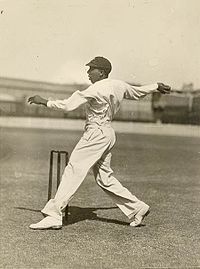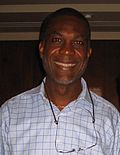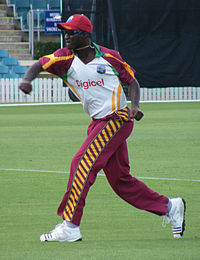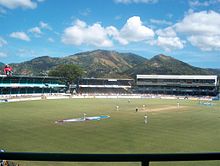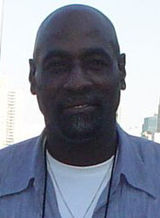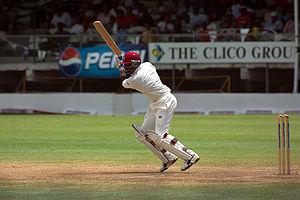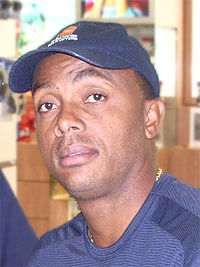
West Indies cricket team
Did you know...
The articles in this Schools selection have been arranged by curriculum topic thanks to SOS Children volunteers. SOS Children has looked after children in Africa for forty years. Can you help their work in Africa?
| West Indies | |
|---|---|
 West Indies cricket crest |
|
| Test status granted | 1928 |
| First Test match | v |
| Captain | |
| Coach | |
| Official ICC Test, ODI and T20I ranking | 7th (Test) 7th (ODI) 1st(T20) |
| Test matches – This year |
490 10 |
| Last Test match | v |
| Wins/losses – This year |
158/162 4/4 |
|
As of 24 August 2012 |
|
The West Indian cricket team, also known as the West Indies or, colloquially, the Windies, is a multi-national cricket team representing a sporting confederation of 15 mainly English-speaking Caribbean countries, British dependencies and non-British dependencies.
From the mid-1970s to the early 1990s, the West Indies team was one of the strongest in the world in both Test and One Day International cricket. A number of cricketers considered among the best in the world have hailed from the West Indies: Sir Garfield Sobers, Lance Gibbs, Gordon Greenidge, George Headley, Brian Lara, Clive Lloyd, Malcolm Marshall, Andy Roberts, Alvin Kallicharran, Rohan Kanhai, Frank Worrell, Clyde Walcott, Everton Weekes, Curtly Ambrose, Michael Holding, Joel Garner and Sir Viv Richards have all been inducted into the ICC Hall of Fame.
The West Indies have won the ICC Cricket World Cup twice, in 1975 and 1979, the ICC World Twenty20 once, in 2012, the ICC Champions Trophy once, in 2004, and were runners up in the Under 19 Cricket World Cup in 2004. The first cricket team to win the World Cup twice, their record was surpassed by four World Cup wins by Australia, and equaled by India in 2011. West Indies are also the first team to win back to back World Cups, since surpassed by three consecutive World Cup wins by Australia (1999, 2003 and 2007). West Indies is the first team to appear in three consecutive World Cup finals (1975, 1979 and 1983), since surpassed by four consecutive World Cup finals appearances by Australia (1996, 1999, 2003 and 2007).
History
The history of the West Indies cricket team began in the 1890s, when the first representative sides were selected to play visiting English sides. The WICB joined the sport's international ruling body, the Imperial Cricket Conference, in 1926, and played their first official international match, granted Test status, in 1928, thus becoming the fourth Test nation.
The last series the West Indies played before the outbreak of the Second World War was against England in 1939. There followed a hiatus that lasted until January 1948 when the MCC toured the West Indies. Of the West Indies players in that first match after the war only Gerry Gomez, George Headley, Jeffrey Stollmeyer, and Foffie Williams had previously played Test cricket. In 1948, leg spinner Wilfred Ferguson became the first West Indian bowler to take ten wickets in a Test, finishing with 11/229 in a match against England; later that same year Hines Johnson became the first West Indies fast bowler to achieve the feat, managing 10/96 against the same opponents. Although blessed with some great players in their early days as a Test nation, and beating England for the first time at Lord's on 29 June 1950, their successes remained sporadic until the 1960s when the side changed from a white-dominated to a black-dominated side. By the 1970s, the West Indies had a side recognised as unofficial world champions, a reputation they retained throughout the 1980s. During these glory years, the West Indies were noted for their four-man fast bowling attack, backed up by some of the best batsmen in the world. In 1976, fast bowler Michael Holding took 14/149 in a Test against England, setting a record which still stands today for best bowling figures in a Test by a West Indies bowler.
The 1980s saw the team set a then-record streak of 11 consecutive Test victories in 1984 and inflict two 5–0 " blackwashes" against the old enemy of England. Throughout the 1990s and 2000s, however, West Indian cricket declined, largely due to the failure of the West Indian Cricket Board to move the game from an amateur pastime to a professional sport, coupled with the general economic decline in West Indian countries, and the team today is struggling to regain its past glory. The West Indies are currently (August 2012) ranked 7th out of 9 Test playing teams (Zimbabwe is not ranked), and 7th in the One Day International rankings, which likewise covers 13 teams.
In their early days in the 1930s, the side represented the British colonies that would later form the West Indies Federation plus British Guiana. The current side represents:
Independent nations
 Antigua and Barbuda
Antigua and Barbuda Barbados
Barbados Dominica
Dominica Grenada
Grenada Guyana
Guyana Jamaica
Jamaica Saint Kitts and Nevis
Saint Kitts and Nevis Saint Lucia
Saint Lucia Saint Vincent and the Grenadines
Saint Vincent and the Grenadines Trinidad and Tobago
Trinidad and Tobago
British dependencies
Other overseas dependencies
 U.S. Virgin Islands
U.S. Virgin Islands Sint Maarten
Sint Maarten
National teams also exist for the various islands, which, as they are all separate countries, very much keep their local identities and support their local favourites. These national teams take part in the West Indian first-class competition, the Carib Beer Cup (earlier known as the Busta Cup, Shell Shield and various other names). It is also common for other international teams to play the island teams for warm-up games before they take on the combined West Indies team.
The official population number for those countries is estimated to around 6 million, which is larger than Scotland and the Republic of Ireland.
Flag and anthem
Most cricketing nations use their own national flags for cricketing purposes. However, as the West Indies represent a number of independent and dependent states, there is no natural choice of flag. The WICB has therefore developed an insignia showing a palm tree and cricket stumps on a small sunny island. This insignia, on a maroon background, makes up the West Indian flag. The background sometimes has a white stripe above a green stripe, which is separated by a maroon stripe, passing horizontally through the middle of the background. Prior to 1999 the WICB(C) had used a similar insignia featuring a palm tree and an island, though there were no stumps and instead of the sun there was the constellation Orion.
For ICC tournaments, "Rally Round the West Indies" by David Rudder is used as the team's anthem.
Venues
The following eleven stadia have been used for at least one Test match. The number of Tests played at each venue followed by the number of One Day Internationals and twenty20 internationals played at that venue is in brackets as of 11 July 2011:
- Queen's Park Oval in Port of Spain, Trinidad (58/61/3)
The Queen's Park Oval has hosted more Test matches than any other ground in the Caribbean and first hosted a Test match in 1930. The ground is considered one of the most picturesque venues in the world of cricket, featuring the view Trinidad's Northern Range. It has a capacity of over 25,000.
- Kensington Oval in Bridgetown, Barbados (48/30/13)
Kensington Oval hosted the region's first Test match in 1930 and is recognised as the 'Mecca' of West Indies cricket. It also played host to the first-ever Test triple century, Andy Sandham's 325. Its capacity has been increased from 15,000 to its current 28,000 for the 2007 World Cup.
- Bourda in Georgetown, Guyana (30/11/0)
Bourda first hosted a Test match in 1930. It was the only Test ground in South America (until the use of Providence), and the only one below sea level and with its own moat (to prevent the pitch from frequent flooding). It has a capacity of around 22,000.
- Sabina Park in Kingston, Jamaica (45/33/0)
Sabina Park first hosted a Test match in 1930. The Blue Mountains, which are famed for their coffee, form the backdrop. Sabina Park played host to Garry Sobers' then world-record 365 not out. In 1998 the Test against England was abandoned here on the opening day because the pitch was too dangerous. It has a capacity of 15,000.
- Antigua Recreation Ground in St John's, Antigua (22/11/0)
Antigua Recreation Ground first hosted a Test in 1981. Three Test triple centuries have been scored on this ground: Chris Gayle's 317 in 2005, and Brian Lara's world record scores of 375 in 1994 and 400 not out in 2004. The historic stadium was removed from the roster of grounds hosting international matches in June 2006, in order to make way for the island's new cricket stadium, being constructed 3 miles outside the capital city expected to be completed in time for its hosting of matches for Cricket World Cup 2007. However, after the abandoned Test match between England and the West Indies in February 2009 at the new North Sound ground, Test cricket returned to the ARG.
- Arnos Vale in Arnos Vale, Kingstown, St Vincent (2/23/0)
The Arnos Vale Ground a.k.a. The Playing Fields first hosted a Test in 1997.
- National Cricket Stadium in St George's, Grenada (2/16/0)
Queen's Park, Grenada first hosted a Test in 2002.
- Beausejour Stadium in Gros Islet, St Lucia (3/23/12)
The Beausejour Stadium first hosted a Test in 2003. It has a capacity of 12,000. This was the first stadium in the Caribbean to host a day-night cricket match. The match was between the West Indies and Zimbabwe. New Zealand is scheduled to play a test in 2014 to mark the return to test cricket after a break of 8 years.
- Warner Park Stadium in Basseterre, St Kitts (3/13/1)
The Warner Park Sporting Complex hosted its first One Day International on 23 May 2006 and its first Test match on 22 June 2006. The stadium has a permanent capacity of 8,000, with provisions for temporary stands to enable the hosting figure to past 10,000.
- Providence Stadium in Georgetown, Guyana (2/11/6)
The Providence Stadium hosted its first One Day International on 28 March 2007 for the 2007 Cricket World Cup and its first Test match on 22 March 2008. The stadium has a permanent capacity of 15,000, and is to host Test cricket instead of Bourda.
- Sir Vivian Richards Stadium in North Sound, Antigua (3/10/2)
The Sir Viv Richards Stadium hosted its first One Day International on 27 March 2007 for the 2007 Cricket World Cup and its first Test match on 30 May 2008. The stadium has a permanent capacity of 10,000, and is to host Test cricket instead of the Antigua Recreation Ground.
- Windsor Park Stadium in Roseau, Dominica (2/4/0)
Windsor Park is another major cricket ground in the West Indies and home venue for the West Indian team. Construction first started on it in 2005, and it finally opened in October 2007, too late to serve as a venue for the 2007 Cricket World Cup. It hosts first-class cricket and hosted its first test on 6 July 2011 against India, however it held its first One Day International on 26 July 2009. It has a seating capacity of 12,000.
Three further stadia have been used for One Day Internationals, but not Test matches. The number of One Day Internationals played at each venue is in brackets:
- Albion Sports Complex in Albion, Berbice, Guyana (5)
- Mindoo Philip Park in Castries, St Lucia (2)
- The old ground of Queen's Park in St George's, Grenada (1)
Clothing
When playing one-day cricket, the Windies wear a maroon shirt, with grey around the sides. The shirt also sports the logo of the West Indian Cricket Board and the name of their sponsors, at present, Digicel. The one-day cap is maroon with the WICB logo on the left of the front, with two yellow stripes separated by a green stripe running vertically on the right of the front.
When playing first-class cricket, in addition to their cricket flannels West Indian fielders sometimes wear a maroon sunhat with a wide brim. The WICB logo is on the middle of the front of the hat. Helmets are coloured similarly.
During World Series Cricket, coloured uniforms were adopted. The initial West Indies uniform was pink and was later changed to maroon to match their Test match caps. Grey was also added as a secondary colour. In some of their uniforms grey has been dominant over the traditional maroon.
West Indian women's cricket team
The West Indian women's cricket team has a much lower profile than the men's team. They played 11 Test matches between 1975–76 and 1979, winning once, losing three times, and drawing the other games. Since then, they have only played one further Test match, a draw game against Pakistan in 2003–04. They also have an infrequent record in One Day Internationals. A team from Trinidad and Tobago and a team from Jamaica played in the first women's World Cup in 1973, with both sides faring poorly, finishing fifth and sixth respectively out of a field of seven. The Windies united as a team to play their first ODI in 1979, but thereafter did not play until the 1993 World Cup. The side has never been one of the leading sides in the world, however, with their main success being achieving second place in the International Women's Cricket Council Trophy, a competition for the second tier of women's national cricket teams, in 2003. They finished in fifth place in the most recent World Cup, which was held in 2004–05. Their overall record in one-dayers is to have played 45, won 17, lost 27 with one no result.
Because of the women's side's relatively low profile, there are few well-known names in the game. The most notable is probably Nadine George, a wicket-keeper/ batsman, who became the first, and to date only, West Indian woman to score a Test century, in Karachi, Pakistan in 2003–04. George is a prominent supporter of sport in the West Indies, and in particular in her native St Lucia, and in 2005 was made an MBE by HRH The Prince of Wales for services to sport.
Statistics and records
Test matches
- Innings totals above 700
For: 790 for 3 declared against Pakistan in Kingston in 1957–58; 751 for 5 declared against England in St John's in 2003–04; 747 all out against South Africa in St John's in 2004–05; 749 for 9 declared against England in Bridgetown in 2008–2009
Against: 849 by England in Kingston in 1929–30; 758 for 8 declared by Australia in Kingston in 1954–55
- Innings totals below 60
For: 47 against England in Kingston in 2003–04; 51 against Australia in Port of Spain in 1998–99; 53 against Pakistan in Faisalabad in 1986–87; 54 against England at Lord's in 2000
Against: 46 by England in Port of Spain in 1993–94; 51 by England in Kingston in 2008–09
- Triple centuries scored for the Windies
400 not out by Brian Lara against England at St John's in 2003–04; 375 by Brian Lara against England at St John's in 1993–94; 365 not out by Garry Sobers against Pakistan at Kingston in 1957–58; 333 by Chris Gayle against Sri Lanka at Galle in 2010–11; 317 by Chris Gayle against South Africa at St John's in 2004–05; 302 by Lawrence Rowe against England at Bridgetown in 1973–74
- Twelve or more wickets taken for the Windies in a Test match
14 for the cost of 149 runs by Michael Holding against England at the Oval in 1976; 13 for 55 by Courtney Walsh against New Zealand in Wellington in 1994–95; 12 for 121 by Andy Roberts against India in Madras in 1974–75
- Hat-Tricks
Wes Hall against Pakistan in 1959; Lance Gibbs against Australia in 1961; Courtney Walsh against Australia in 1988; and Jermaine Lawson against Australia in 2003
One day matches
- Hat-trick
An ODI hat-trick performance was made by Jerome Taylor on 19 October 2006 at Mumbai in an ICC Champions Trophy league match against Australia.
At the ICC 2011 Cricket World Cup, Kemar Roach became the sixth bowler to claim a World Cup hat-trick against the Netherlands.
Squad
This lists all the players who have played for West Indies in the past year and the forms in which they have played. Correct as of 25 February 2013.
- Coaching staff
- Head Coach: Ottis Gibson
- Assistant Coach: Toby Radford
- Batting Coach: Desmond Haynes
- Team's Manager: Richie Richardson
Test captains
The following men have captained the West Indian cricket team in at least one Test match:
| West Indian Test match captains | ||
|---|---|---|
| Number | Name | Period |
| 1 | Karl Nunes | 1928-1929/30 |
| 2 | Teddy Hoad | 1929/30 |
| 3 | Nelson Betancourt | 1929/30 |
| 4 | Maurice Fernandes | 1929/30 |
| 5 | Jackie Grant1 | 1930/31-1934/35 |
| 6 | Rolph Grant1 | 1939 |
| 7 | George Headley | 1947/48 |
| 8 | Gerry Gomez | 1947/48 |
| 9 | John Goddard | 1947/48-1951/52, 1957 |
| 10 | Jeffrey Stollmeyer | 1951/52-1954/55 |
| 11 | Denis Atkinson | 1954/55-1955/56 |
| 12 | Gerry Alexander | 1957/58-1959/60 |
| 13 | Frank Worrell | 1960/61-1963 |
| 14 | Garfield Sobers | 1964/65-1971/72 |
| 15 | Rohan Kanhai | 1972/73-1973/74 |
| 16 | Clive Lloyd | 1974/75-1977/78, 1979/80-1984/85 |
| 17 | Alvin Kallicharran | 1977/78-1978/79 |
| 18 | Deryck Murray | 1979/80 |
| 19 | Viv Richards | 1980, 1983/84-1991 |
| 20 | Gordon Greenidge | 1987/88 |
| 21 | Desmond Haynes | 1989/90-1990/91 |
| 22 | Richie Richardson | 1991/92-1995 |
| 23 | Courtney Walsh | 1993/94-1997/98 |
| 24 | Brian Lara | 1996/97-1999/2000, 2002/03-2004, 2006–2007 |
| 25 | Jimmy Adams | 1999/2000-2000/01 |
| 26 | Carl Hooper | 2000/01-2002/03 |
| 27 | Ridley Jacobs | 2002/03 |
| 28 | Shivnarine Chanderpaul | 2004/05-2005/06 |
| 29 | Ramnaresh Sarwan | 2007 |
| 30 | Daren Ganga | 2007 |
| 31 | Chris Gayle | 2007, 2008–2010 |
| 32 | Dwayne Bravo | 2008 |
| 33 | Floyd Reifer | 2009 (due to contract dispute) |
| 34 | Darren Sammy | 2010–present |
Note: 1 Jackie and Rolph Grant were brothers
Tournament history and honours
World Cup
(This is the leading international one-day tournament, held approximately every four years since 1975.)
- 1975: Champions
- 1979: Champions
- 1983: Runners up
- 1987: First round
- 1992: First round (6th place)
- 1996: Semifinals
- 1999: First round
- 2003: First round
- 2007: Super-eight stage (6th place)
- 2011: Quarterfinals
ICC World Twenty20
- 2007: First round
- 2009: Semifinals
- 2010: Super-eight stage
- 2012: Champions
ICC Champions Trophy
Known as the "ICC Knockout" in 1998 and 2000.
- 1998: Runners up
- 2000: First round
- 2002: First round
- 2004: Champions
- 2006: Runners up
- 2009: First round
World Championship of Cricket
- 1985: Third place
